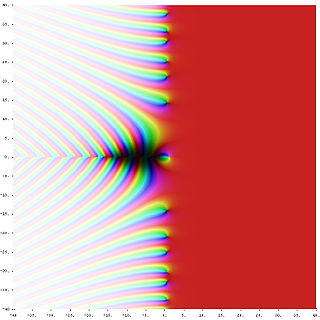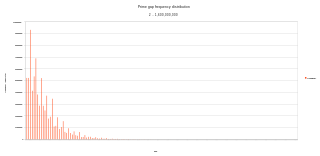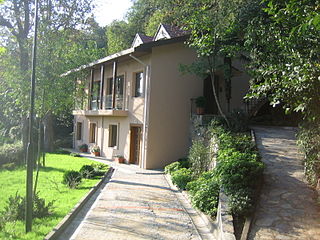A twin prime is a prime number that is either 2 less or 2 more than another prime number—for example, either member of the twin prime pair or (41, 43). In other words, a twin prime is a prime that has a prime gap of two. Sometimes the term twin prime is used for a pair of twin primes; an alternative name for this is prime twin or prime pair.

In mathematics, analytic number theory is a branch of number theory that uses methods from mathematical analysis to solve problems about the integers. It is often said to have begun with Peter Gustav Lejeune Dirichlet's 1837 introduction of Dirichlet L-functions to give the first proof of Dirichlet's theorem on arithmetic progressions. It is well known for its results on prime numbers and additive number theory.
In number theory, Cramér's conjecture, formulated by the Swedish mathematician Harald Cramér in 1936, is an estimate for the size of gaps between consecutive prime numbers: intuitively, that gaps between consecutive primes are always small, and the conjecture quantifies asymptotically just how small they must be. It states that
Sieve theory is a set of general techniques in number theory, designed to count, or more realistically to estimate the size of, sifted sets of integers. The prototypical example of a sifted set is the set of prime numbers up to some prescribed limit X. Correspondingly, the prototypical example of a sieve is the sieve of Eratosthenes, or the more general Legendre sieve. The direct attack on prime numbers using these methods soon reaches apparently insuperable obstacles, in the way of the accumulation of error terms. In one of the major strands of number theory in the twentieth century, ways were found of avoiding some of the difficulties of a frontal attack with a naive idea of what sieving should be.
In number theory, the Elliott–Halberstam conjecture is a conjecture about the distribution of prime numbers in arithmetic progressions. It has many applications in sieve theory. It is named for Peter D. T. A. Elliott and Heini Halberstam, who stated the conjecture in 1968.
Cem Yalçın Yıldırım is a Turkish mathematician who specializes in number theory.
Legendre's conjecture, proposed by Adrien-Marie Legendre, states that there is a prime number between and for every positive integer . The conjecture is one of Landau's problems (1912) on prime numbers; as of 2023, the conjecture has neither been proved nor disproved.
In number theory, Polignac's conjecture was made by Alphonse de Polignac in 1849 and states:

A prime gap is the difference between two successive prime numbers. The n-th prime gap, denoted gn or g(pn) is the difference between the (n + 1)-st and the n-th prime numbers, i.e.

At the 1912 International Congress of Mathematicians, Edmund Landau listed four basic problems about prime numbers. These problems were characterised in his speech as "unattackable at the present state of mathematics" and are now known as Landau's problems. They are as follows:
- Goldbach's conjecture: Can every even integer greater than 2 be written as the sum of two primes?
- Twin prime conjecture: Are there infinitely many primes p such that p + 2 is prime?
- Legendre's conjecture: Does there always exist at least one prime between consecutive perfect squares?
- Are there infinitely many primes p such that p − 1 is a perfect square? In other words: Are there infinitely many primes of the form n2 + 1?
In number theory, the Green–Tao theorem, proved by Ben Green and Terence Tao in 2004, states that the sequence of prime numbers contains arbitrarily long arithmetic progressions. In other words, for every natural number k, there exist arithmetic progressions of primes with k terms. The proof is an extension of Szemerédi's theorem. The problem can be traced back to investigations of Lagrange and Waring from around 1770.
In number theory, Maier's theorem is a theorem about the numbers of primes in short intervals for which Cramér's probabilistic model of primes gives a wrong answer.
János Pintz is a Hungarian mathematician working in analytic number theory. He is a fellow of the Rényi Mathematical Institute and is also a member of the Hungarian Academy of Sciences. In 2014, he received the Cole Prize.
János Komlós is a Hungarian-American mathematician, working in probability theory and discrete mathematics. He has been a professor of mathematics at Rutgers University since 1988. He graduated from the Eötvös Loránd University, then became a fellow at the Mathematical Institute of the Hungarian Academy of Sciences. Between 1984–1988 he worked at the University of California, San Diego.

In number theory, Firoozbakht's conjecture is a conjecture about the distribution of prime numbers. It is named after the Iranian mathematician Farideh Firoozbakht who stated it first in 1982.

The Istanbul Center for Mathematical Sciences (IMBM) is an independent center for mathematics situated in the South Campus of Boğaziçi University, Istanbul, in close proximity to the Mathematics Department. The center was initiated by several major universities in Istanbul and was formally inaugurated in 2006. The center aims to host and encourage the mathematical research and the interaction of researchers.

YitangZhang is a Chinese-American mathematician primarily working on number theory and a professor of mathematics at the University of California, Santa Barbara since 2015.

James Alexander Maynard is an English mathematician working in analytic number theory and in particular the theory of prime numbers. In 2017, he was appointed Research Professor at Oxford. Maynard is a fellow of St John's College, Oxford. He was awarded the Fields Medal in 2022 and the New Horizons in Mathematics Prize in 2023.
Daniel Larsen is an American mathematician known for solving a 1994 conjecture of W. R. Alford, Andrew Granville and Carl Pomerance on the distribution of Carmichael numbers, commonly known as Bertrand's postulate for Carmichael numbers.
The Goldston-Pintz-Yıldırım sieve is a sieve method and variant of the Selberg sieve with generalized, multidimensional sieve weights. The sieve led to a series of important breakthroughs in analytic number theory.














